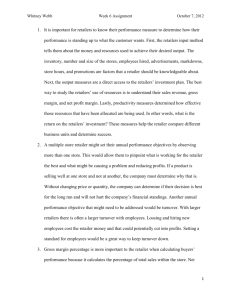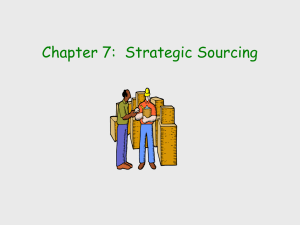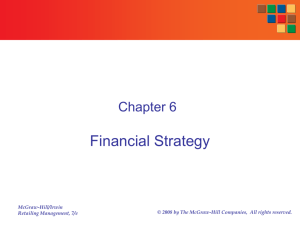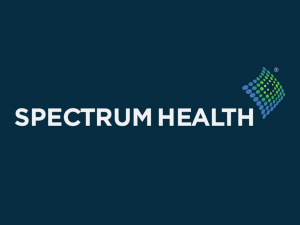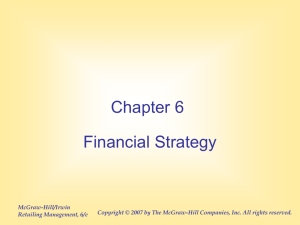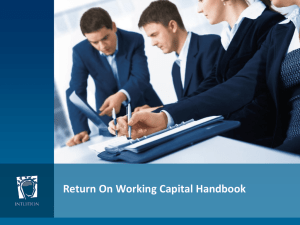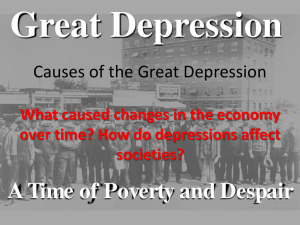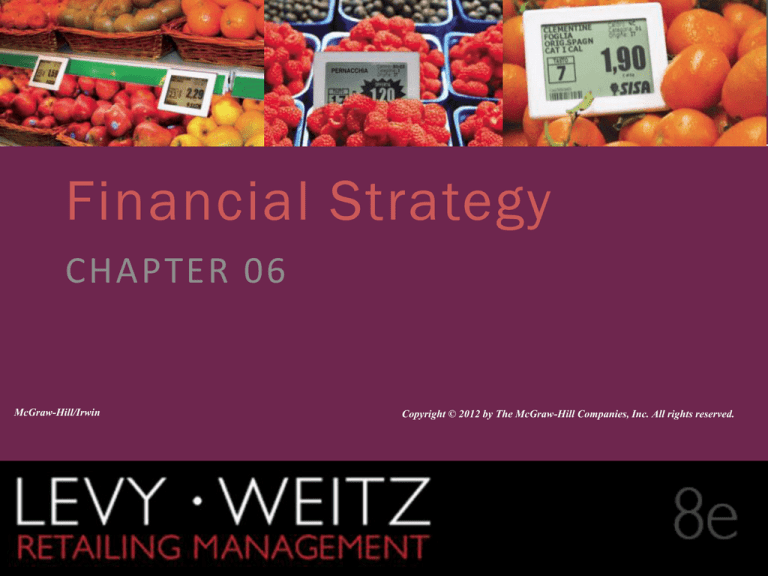
CHAPTER 6
2
1
Financial Strategy
CHAPTER 06
McGraw-Hill/Irwin
Retailing Management 8e
Copyright © 2012 by The McGraw-Hill Companies, Inc. All rights reserved.
© The McGraw-Hill Companies, All rights reserved.
6-1
Retailing Strategy
CHAPTER 6
2
1
Retail Market Strategy
Financial Strategy
Retail Locations
Retail Site Location
Human Resource Management
Information Systems and Supply Chain Management
Customer Relationship Management
6-2
Questions
CHAPTER 6
2
1
• How is a retail strategy reflected in retailers’ financial
objectives?
• How do retailers need to evaluate their performance?
• What is the strategic profit model, and how is it used?
• What measures do retailers use to assess their
performance?
6-3
Objectives and Goals
CHAPTER 6
2
1
• Financial – not necessarily profits, but return on
investment (ROI) – primary focus
• Societal – helping to improve the world around us
• Personal – self-gratification, status, respect
6-4
Components of the
Strategic Profit Model
CHAPTER 6
2
1
6-5
The Strategic Profit Model:
An Overview
CHAPTER 6
2
1
Profit Margin x
Asset turnover
= Return on assets
Net profit
x
Net sales (crossed out)
Net sales (crossed out) = Net profit
Total assets
Total assets
Net Profit Margin: reflects the profits generated from each dollar of sales
Asset Turnover: assesses the productivity of a firm’s investment in its assets
6-6
Fiscal Annual Income Statement for
Family Dollar and Nordstrom
**
CHAPTER 6
2
1
**
** ($ millions)
6-7
Profit Management Path for Family
Dollar Stores and Nordstrom
CHAPTER 6
2
1
6-8
Profit Margin Management Path
CHAPTER 6
2
1
• Net Sales = Gross Sales + Promotional
Allowances - Return
• Cost of Good Sold (COGs)
• Gross Margin (GM) = Net Sales - COGs
6-9
Profit Margin Management Path
CHAPTER 6
2
1
• Operating Expense
• Variable (e.g.. sales commissions)
• Fixed (rent, depreciation, staff salaries)
• Selling, general, and administrative (SG&A) expenses
6 - 10
Profit Margin Management Path
CHAPTER 6
2
1
• Operating profit margin
• Operating profit margin = Gross margin - Operating
expenses - Extraordinary (recurring) operating
expenses
• Net profit margin = Operating profit margin - Taxes Interest - Extraordinary nonrecurring expenses
6 - 11
Profit Margin Management Path
CHAPTER 6
2
1
• Gross margin percentage is gross margin divided by net
sales.
• Retailers use to compare
• the performance of various types of merchandise
• their own performance with that of other retailers
with higher or lower levels of sales.
Gross margin
Net sales
= Gross margin %
6 - 12
Profit Margin Management Path
CHAPTER 6
2
1
• SG & A or operating expenses can be expressed as a
percentage of net sales to facilitate comparisons across
items, stores, and merchandise categories within and
between firms.
Operating expenses
Net sales
= Operating expenses %
6 - 13
Profit Margin Management Path
CHAPTER 6
2
1
• Net operating profit percentage is gross margin minus
operating expenses divided by net sales
Gross margin - Operating expenses
Net sales
= Net operating profit %
6 - 14
Asset Management Path
CHAPTER 6
2
1
• Assets:
• Economic Resources (e.g., inventory, buildings,
computers, store fixtures) owned or controlled by a
firm
• Current Asset and Fixed Asset
• Current Assets = Cash + Account Receivable +
Inventory + Other current assets
6 - 15
Asset Management Path
CHAPTER 6
2
1
• Accounts receivable are primarily the monies owed to
the retailer by customers that have bought merchandise
on credit.
• Fixed Assets = Fixture, Stores (owned)
• Asset Turnover = Sales/Total Assets
Net sales
Total assets
= Asset turnover
• Inventory Turnover = COGS/Avg. Inventory (cost)
Cost of goods sold
Average inventory at cost
= Inventory turnover
6 - 16
Asset Information from Family Dollar Stores’
and Nordstrom’s Balance Sheets
*
CHAPTER 6
2
1
*
* ($ millions)
6 - 17
Asset Management Path for Family
Dollar and Nordstrom
CHAPTER 6
2
1
6 - 18
Inventory Turnover
CHAPTER 6
2
1
• A Measure of the Productivity of Inventory:
• It is used to evaluate how effectively retailers utilize
their investment in inventory
• Shows how many times, on average, inventory cycles
through the store during a specific period of time
(usually a year)
Inventory Turnover = COGS/avg inventory (cost)
Inventory Turnover = Sales/ avg inventory (retail)
6 - 19
Strategic Profit Model Ratios for
Selected Retailers
CHAPTER 6
2
1
6 - 20
Income Statement Information for Gifts To Go Stores
and Proposed Gifts-To-www.Go.com Internet
Channel
CHAPTER 6
2
1
6 - 21
Balance Sheet Information for Gifts To Go Stores and
Proposed Gifts-To-www.Go.com Internet Channel
CHAPTER 6
2
1
6 - 22
Analysis of Financial Strength
CHAPTER 6
2
1
• Cash-Flow Analysis
• Retailers need cash to meet their obligations — i.e.,
salary, rent, vendors, etc.
• Cash flow is calculated by making adjustments to net
profit involving adding or subtracting differences in
revenue and expenses that occur from one period to
the next.
6 - 23
Analysis of Financial Strength
CHAPTER 6
2
1
• Debt-Equity Ratio
• The retailer’s short- and long-term debt divided by the
value of the owners’ or stockholders’ equity.
• Current Ratio
• The is short-term assets divided by short-term
liabilities, it evaluates the retailer’s ability to pay its
short-term debt obligations.
6 - 24
Analysis of Financial Strength
CHAPTER 6
2
1
• Quick Ratio
• “acid-test ratio”
• More stringent test because it removes inventory
from the short-term assets.
• If a retailer needs cash to pay its short-term liabilities,
it cannot rely on inventory to provide an immediate
source for cash.
6 - 25
Setting and
Measuring Performance Objectives
CHAPTER 6
2
1
• Retailers will be better able to gauge performance if it
has specific objectives in mind to compare performance.
• Should include:
• numerical index of performance desired
• time frame for performance
• necessary resources to achieve objectives
6 - 26
Setting Objectives
in Large Retail Organizations
CHAPTER 6
2
1
Top-Down Planning
Corporate Developmental Strategy
Category, Departments
and sales associates
implement strategy
6 - 27
Setting Objectives
in Large Retail Organizations
CHAPTER 6
2
1
Corporate
Bottom-Up Planning
Buyers and Store
managers estimate
what they can
achieve
Operation managers
must be involved in
objective setting
process
6 - 28
Productivity Measures
CHAPTER 6
2
1
Input Measures – assess the amount of resources or
money used by the retailer to achieve outputs such as
sales
Output measures – asses the results of a retailer’s
investment decisions
Productivity measure – determines how effectively
retailers use their resource – what return (e.g., profits)
they get on their investments (e.g., expenses)
6 - 29
Financial Performance of Retailers
Outputs – Performance
Inputs Used by Retailers
•
•
•
•
•
•
•
•
•
Sales
Profits
Cash flow
Growth in sales, profits
Same store sales growth
CHAPTER 6
2
1
Inventory ($)
Real Estate (sq. ft.)
Employees (#)
Overhead (Corporate Staff
and Expenses)
• Advertising
• Energy Costs
• MIS expenses
6 - 30
Examples of Performance
Measures Used by Retailers
CHAPTER 6
2
1
6 - 31
Assessing Performance
CHAPTER 6
2
1
• Growth in Stockholder Value – Stock Price
• Accounting Measures – ROA (Risk adjusted)
• Benchmark
• Performance Over Time
• Compare performance indicator for three years
• Performance Compared to Competitors
• Compare performance indicators with major competitors for
one year, most recent
6 - 32


